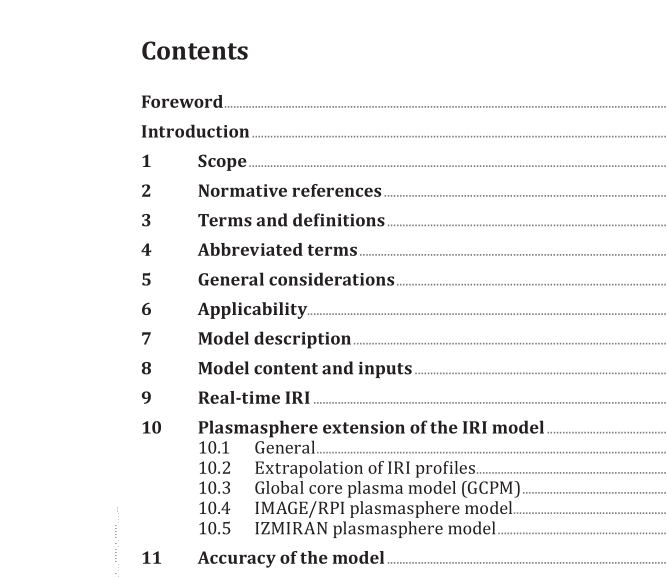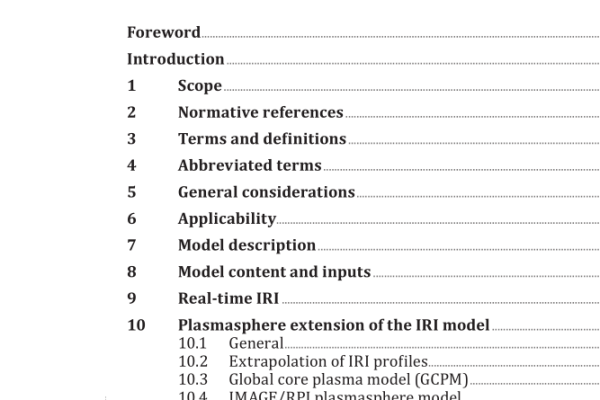ISO 16457:2022 pdf download – Space environment (natural and artificial) — The Earth’s ionosphere model — International reference ionosphere (IRI) model and extensions to the plasmasphere.
3.4 solar activity series of processes occurring in the Sun’s atmosphere which affect the interplanetary space and the Earth Note 1 to entry: The level of solar activity is characterized by indices. 3.5 ionospheric storm storm lasting about a day, documented by depressions and/or enhancements of the ionospheric electron density during various phases of the storm Note 1 to entry: Ionospheric storms are the ultimate result of solar flares or coronal mass ejections, which produce large variations in the particle and electromagnetic radiation that hit Earth’s magnetosphere and ionosphere (3.1), as well as large-scale changes in the global neutral wind, composition and temperature. 3.6 sunspot number R daily index of sunspot activity defined as k(10 g + s) where s is the number of individual spots, g is the number of sunspot groups, and k is an observatory factor Note 1 to entry: R is alternatively called Ri or Rz or SSN. Note 2 to entry: R12 is 12-month running mean of monthly sunspot number. Note 3 to entry: In 2014 the calculation scheme for the officially distributed sunspot number was changed [68] with the result that the new sunspot number (SSN2) is about a factor of 1,45 larger than the old one (SSN1). 3.7 F10.7 solar radio flux at 10,7 cm wavelength measured at the ground daily at noon Note 1 to entry: Besides this ‘observed’ F10.7 index there is also an ‘adjusted’ F10.7 index that is adjusted to 1AU. Often used averages are the 81-day (3 solar rotations) running mean and the 12-month running mean. 3.8 Lyman-α index solar activity (3.4) index based on daily measured solar emission at 121,6 nm (H Lyman-α line) 3.9 MGII index solar activity (3.4) index based on core-to-wing ratio of the magnesium ion h and k lines at 279,56 nm and 280,27 nm 3.10 Kp index planetary three-hour index of geomagnetic activity characterizing the disturbance in the Earth’s magnetic field over three-hour universal time (UT) intervals [87] Note 1 to entry: The index scale is uneven quasi-logarithmic and assigned to successive 3 h UT intervals giving eight values per UT day, and ranges in 28 steps from 0 (quiet) to 9 (disturbed). 3.11 ap index three-hour UT amplitude index of geomagnetic variation equivalent to the Kp index (3.10) Note 1 to entry: It is expressed in 1 nT to 400 nT.
3.12 total electron content TEC integral number of electrons in the unitary area column from a lower altitude boundary to an upper boundary Note 1 to entry: Typically, the integral is taken from the lower boundary of the ionosphere (3.1) to the plasmapause (3.3) Note 2 to entry: It is expressed in units of 10 16 electrons m −2 (TECU). 3.13 TECg TEC-based global index global ionospheric index based on GNSS-derived TEC-noon measurements at the network of IGS stations Note 1 to entry: See References [70] and [82] for more information on IGS stations. 3.14 GEC global electron content integral of TEC (3.12) over the whole globe based on GNSS-derived TEC measurements
ISO 16457:2022 pdf download – Space environment (natural and artificial) — The Earth’s ionosphere model — International reference ionosphere (IRI) model and extensions to the plasmasphere






